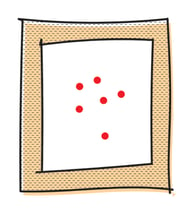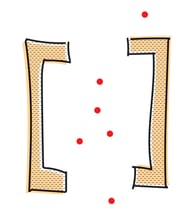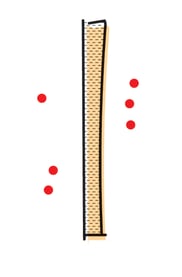By: Laura Meade
This March was the third anniversary of when COVID-19 hit the globe. It has been a great tribulation for all of us. It has been traumatizing, challenging, and very human.
I am considering how boundaries, edges, and lines- integral design elements- also provide a framework for understanding our environment. As we are struggling our way out of the pandemic, there are new protocols and rules for engaging with each other.
Boundaries
Boundaries define limits. They are designed to provide privacy, security, and often to establish a clear separation between distinct functional areas in a building. A boundary's design can have a profound impact on the experience of the user, influencing factors like natural light, airflow, and temperature. The COVID-19 pandemic taught us that boundaries can be the physical markers indicating appropriate distance to maintain between people in a space. Signs and floor stickers instructed us to keep our distance while physical screens and partitions provided us with less subtle visual cues for how to behave in public spaces to prevent close contact.
 Edges
Edges
Edges, on the other hand, are the threshold between boundaries- physical or perceived. In architecture, edges create a sense of hierarchy, guiding users through space and creating a legible sense of flow.
The edge is also a threshold between what is and is not; the same and the other. In June 2020, the Black Lives Matter protests instigated critical conversation and brought more awareness of the imbalanced systemic structures on which our country was constructed. American urban planning has been used for decades to create physical and social edges, excluding certain groups of people from accessing resources and opportunities, creating segregated communities, and perpetuating racial and economic inequality. The protests indicated a social change tipping point that set off a period of intense listening and watching by all parties. Being invited to look at the edges of what we took for granted- stability, security, or the ability to turn a blind eye- set in motion a period of significant and widespread change.
 Lines
Lines
Lines define edges. Horizontal lines create stability, while vertical lines create height and a sense of grandeur. Diagonal lines create a sense of movement or tension. Lines in architectural design impact the overall character of a space, influencing factors like mood and energy.
The COVID-19 pandemic transformed how we think about lines, both physical and conceptual. The blurred distinction between home and work had to be reckoned with, as millions of people around the world transitioned to working from home. This shift had a profound impact on the way we live and work today, with many people still struggling to maintain a healthy work-life balance in the absence of a clear line drawn between their personal and professional lives.
The pandemic drew a hard line between public and private spaces, with lockdowns and social distancing guidelines requiring people to restrict their movement and interactions with others. As a result, many public spaces were closed or reimagined as sites for socially distanced activities like outdoor dining and exercise. This led to a reevaluation of the role played by public spaces in our communities and the need for them to be adaptable and responsive to changing circumstances.
COVID-19 highlighted the interconnectedness of global systems and the need for collaboration and cooperation across lines of all kinds. The emergence and spread of the virus demonstrated the ways in which our actions and decisions could have a profound impact on people and communities far beyond our immediate surroundings, emphasizing the need for collective action and a shared sense of responsibility.
What Have We Learned?
The use of boundaries, edges, and lines in design creates spaces that are both functional and aesthetically appealing while providing a sense of connection to the surrounding environment. Their use has become increasingly fluid, and we are learning to explore the ways in which these elements can be manipulated to create more dynamic and legible post-pandemic spaces. From the use of materials that blur the distinction between interior and exterior to the integration of natural elements that enhance sensory experiences, architecture can push the boundaries of conventional understanding to offer intentional cues to users indicating how transparent and welcoming a particular space might be or how it may be used. With careful consideration of these design elements, we will learn from the COVID-19 pandemic to shape our new experience of the world around us.





